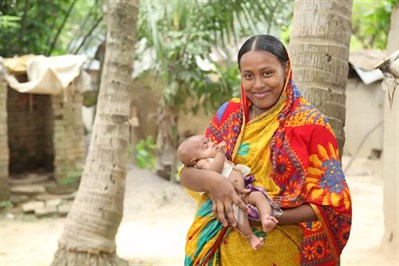
photo credit: BRAC
By Sally Theobald, 11 October 2013
Wikipedia declares BRAC to be the largest Non Governmental Organisation in the World, based on how many people it employs and the number of people it has helped. BRAC is present in all 64 districts of Bangladesh as well as in Afghanistan, Pakistan, Sri Lanka, Uganda, Tanzania, South Sudan, Sierra Leone, Liberia, Haiti and The Philippines and has offices in the UK and the USA. The James P. Grant School of Public Health (JPGSPH) was established in 2004 and its founding members are BRAC, BRAC University and icddr,b. JPGSPH draws on these founding members – or institutional pillars – to inform and enrich its programmes and activities, which include research, education, leadership and advocacy. JPGSPH has over 200 members of staff and a vibrant MPH programme which attracts students from Bangladesh and all over the world.
Close-to-community providers and menstrual regulation
I have just spent a week at JPGSPH with Hermen Ormel from KIT, in a REACHOUT analysis workshop for looking at qualitative data on the role of - and interactions between - formal and informal close–to-community (CTC) providers. JPGSPH have focused their work on sexual and reproductive health (and in particular menstrual regulation) in 2 sites in Dhaka and 2 sites in Sylhet district. Menstrual regulation is a procedure that uses manual vacuum aspiration to safely establish nonpregnancy up to 8-10 weeks after a missed period. Research by icddr,b concluded that,
“The provision of menstrual regulation averts unsafe abortion and associated maternal morbidity and mortality, and on a per case basis, saves scarce health system resources. Increasing access to menstrual regulation would enable more women to obtain much-needed care and health system resources to be utilized more efficiently.”
Building capacity through South-South technical assistance
JPGSPH leads on REACHOUT capacity building work under the direction of Prof. Malabika Sarker –Director of Research - and Yamin Jahinger. A key activity in REACHOUT capacity building is South-south technical assistance to ensure that we build on the strengths and experience of all partners in designing, implementing and evaluating the quality improvement cycles that we will undertake to strengthen CTC services. There are a number of work areas where JPGSPH have exciting lessons to share. These include:
- Supporting supervision, retention and motivation of CTC providers to build responsive health systems: There are 97,000 frontline community health workers - shasthya shebika in Bengali – who are linked to BRAC. Retention and motivation is supported through: community involvement in the recruitment process; continuous learning and training through refresher training; structured supervision and monitoring based on performance and continuous recognition and promotion of shastya shebika as key pillars within BRAC. This female volunteer cadre has been crucial to health gains in Bangladesh. For example in maternal health shasthya shebika work with traditional birth attendants to support maternal and child health with an approach that aims to empower and support women. Maternal mortality has dropped sharply and steadily, from 574 maternal deaths per 100,000 live births in 1990 to just 194 in 2010, while other indicators like neonatal and under-five mortality have also fallen.
- Taking forward equity as a core component of front line service delivery and universal health coverage: JPGSPH hosts the Centre for Universal Health Coverage which aims to facilitate efforts to accelerate evidence-informed, equitable and sustainable action towards universal health coverage. The Centre includes a Universal Health Coverage Forum for evidence informed advocacy and joint learning with local and global partners. They are also part of the Centre for Urban Equity and Health – a knowledge hub on urban health equity with a focus on human resources and service delivery. While the Bangladesh Health Watch, also hosted by JPGSPH, is a multi-stakeholder civil society advocacy and monitoring network dedicated to improve the health system in Bangladesh through critical review of policies and programmes and recommendation of appropriate actions for change. Gender equity is also an area of expertise and action through the Centre for Gender, Sexual and Reproductive Health Rights which can support analysis of the ways in which gender roles and relations shape CTC providers experiences and interactions with both communities and the rest of the health system.
A week at JPGSH and BRAC left me feeling excited about the potential of south-south technical assistance in the REACHOUT journey.

This project is funded by the European Union.
